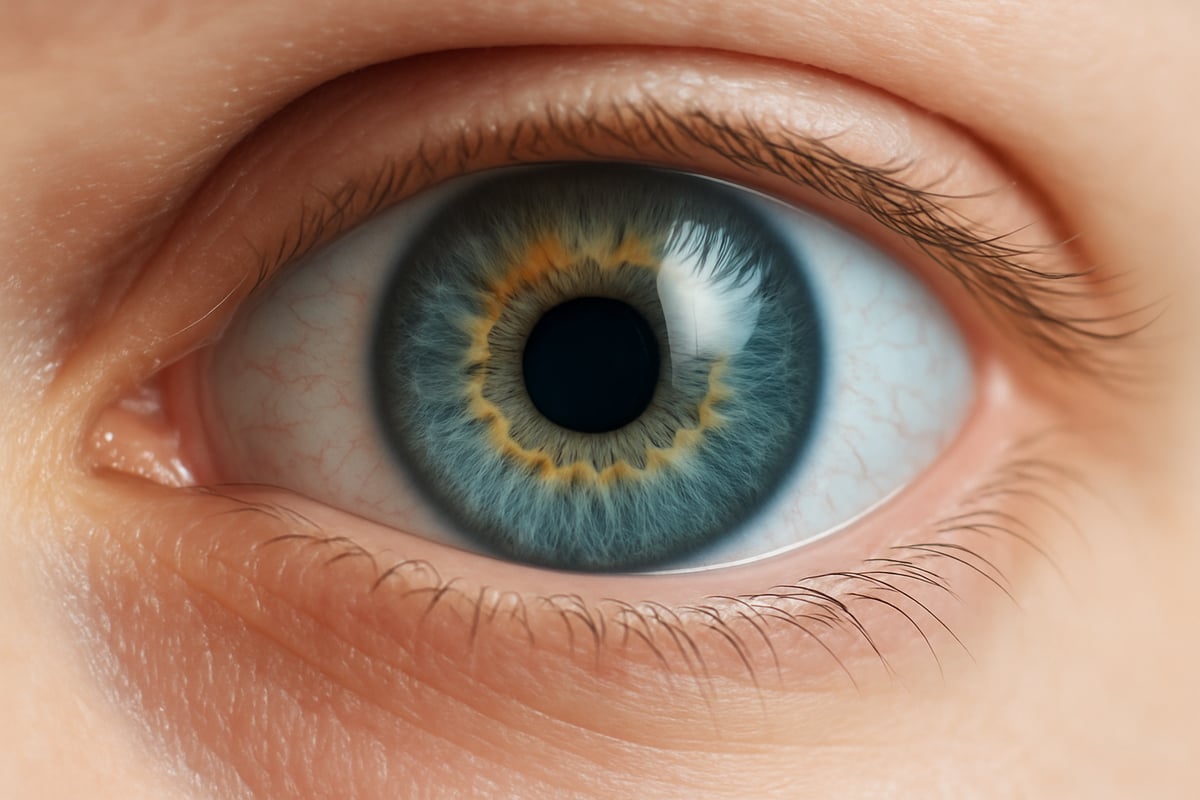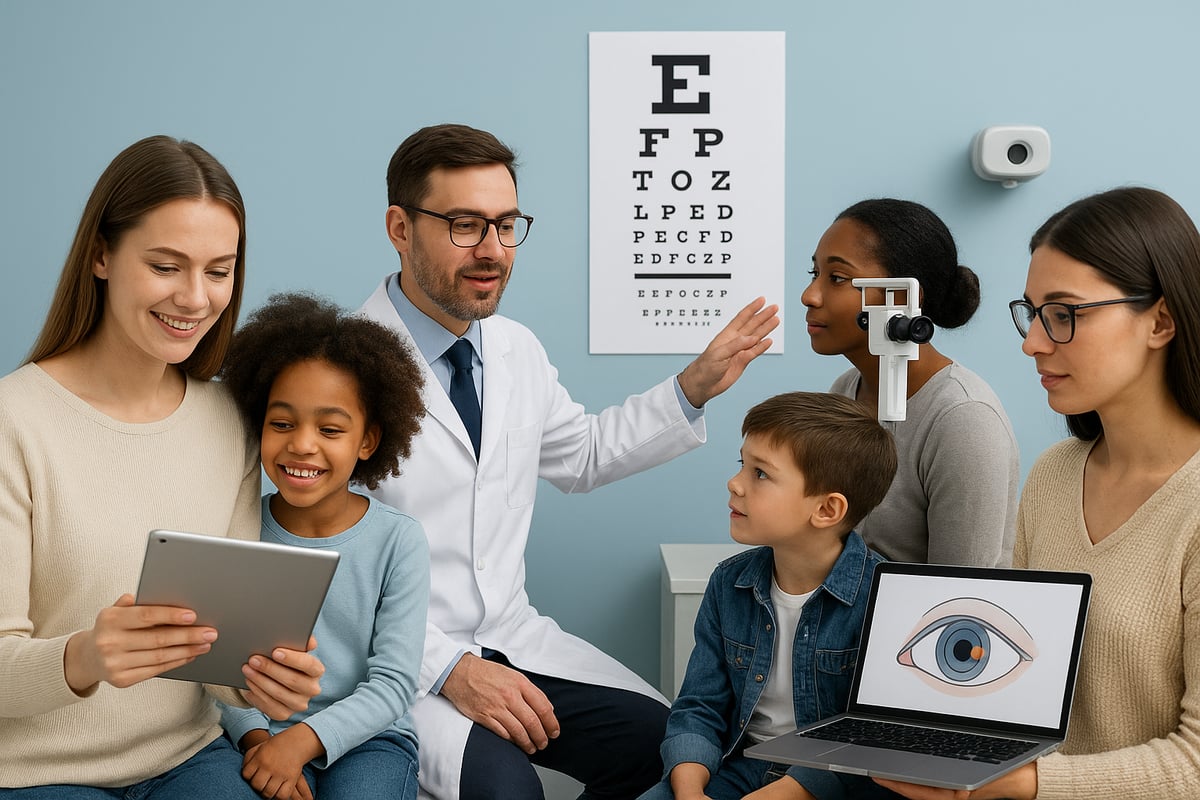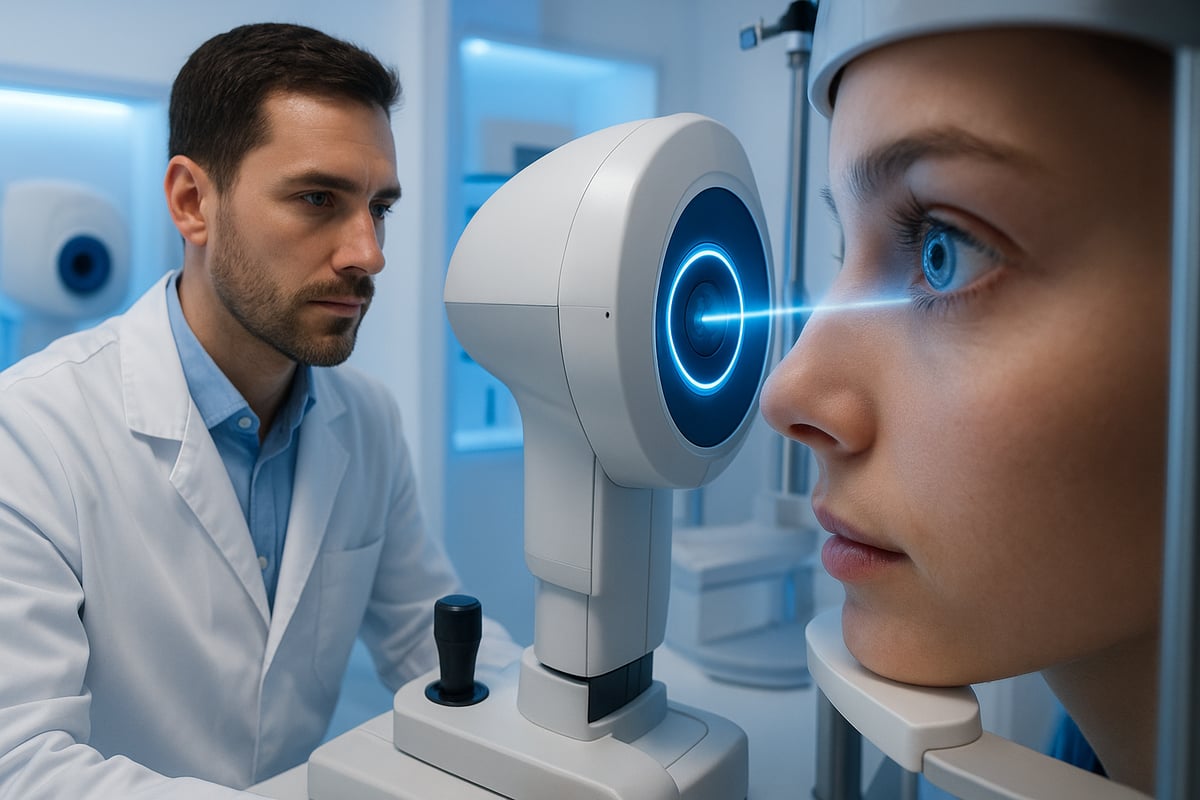Unlock the secrets behind your eye and discover how vision truly works in 2025. Our eyes are remarkable organs, yet many people do not fully understand their complexity or how to protect them.
This guide demystifies the structure, function, and care of your eye, offering the latest knowledge and advancements. You will learn about common conditions, breakthroughs in modern treatments, and practical strategies to maintain lifelong eye health.
Curious about how to keep your sight sharp? Read on for expert insights, fascinating facts, and actionable tips to empower you on your journey to better vision.
The Anatomy of the Eye: Structure and Function
Understanding the intricate design of your eye is the first step to appreciating how you see the world. Every layer and structure within your eye works together, shaping the clarity, color, and detail of your vision.

Layers and Components of the Eye
Your eye is made up of several essential layers and components, each with a unique role. The outermost layer, the cornea, acts as a clear window, allowing light to enter. Behind it, the lens focuses incoming light onto the retina, which lines the back of your eye. The retina is a thin, sensitive layer packed with more than 100 million photoreceptor cells.
The white outer coat, known as the sclera, provides structure and protection. Inside, the choroid supplies nutrients and oxygen, while the retina transforms light into electrical signals. The macula, a small area within the retina, is responsible for central vision and detecting fine detail and color.
At the center, the iris controls how much light enters your eye by adjusting the size of the pupil. The clear, gel-like vitreous humor fills the middle and helps maintain the shape of your eye.
Did you know your eye can distinguish about 10 million colors? This remarkable ability comes from the combined action of the retina and macula. For a detailed look at each structure and its function, explore this Human eye anatomy and function resource.
How Vision Works: From Light to Image
The journey of vision begins when light enters your eye through the cornea. This light is bent, or refracted, by the lens and cornea, focusing the image onto the retina. Inside the retina, two types of photoreceptors, rods and cones, convert light into electrical signals. Rods help you see in low-light conditions, while cones allow you to perceive color and fine detail.
Once these signals are generated, they travel along the optic nerve to the brain. Here, your brain processes the data, assembling the signals into the images you recognize. Blinking plays a critical role as well, spreading tears to keep your eye moist and clear of debris, ensuring that your vision remains sharp.
Your eye relies on this seamless process every second, turning light into the rich, colorful world you see. Each step, from refraction to brain interpretation, is vital for clear, accurate sight.
Eye Growth and Changes Over Time
From infancy through adulthood, your eye undergoes remarkable changes. During childhood, the eye grows rapidly, with the shape and length adjusting to achieve focused vision. As you age, the lens of your eye gradually loses flexibility, making it harder to focus on close objects. The pupil may also become smaller, reducing the amount of light entering your eye.
With time, you may notice shifts in vision, such as presbyopia or increased sensitivity to glare. Fortunately, research shows that 80 percent of vision problems worldwide are preventable or curable, according to the World Health Organization in 2023.
Caring for your eye at every stage of life is essential. Regular checkups and awareness of age-related changes can help you protect your sight for years to come.
Common Eye Conditions in 2025: Risks, Symptoms, and Prevention
Understanding the most common conditions affecting your eye in 2025 is crucial for maintaining lifelong vision. With new risks emerging and prevention strategies evolving, knowing what to watch for can make all the difference.

Refractive Errors: Myopia, Hyperopia, Astigmatism, Presbyopia
Refractive errors are the most widespread conditions impacting your eye. These include myopia (nearsightedness), hyperopia (farsightedness), astigmatism, and presbyopia. Causes range from genetics to environmental factors like screen time.
Myopia now affects nearly 30 percent of the global population. Symptoms to watch for include blurred vision, headaches, and eye strain. Regular vision screenings can help detect these issues early.
Treatment options for your eye include prescription glasses, contact lenses, and advanced procedures such as LASIK. Preventive steps like managing screen habits and ensuring proper lighting can reduce the risk of worsening refractive errors.
Degenerative Eye Diseases: Macular Degeneration, Glaucoma, Cataracts
Degenerative diseases are a major concern for your eye, especially as you age. Macular degeneration, glaucoma, and cataracts each affect different structures within the eye and can lead to vision loss if left untreated.
Age, genetics, and systemic conditions like diabetes are primary risk factors. Early signs may include loss of central vision, peripheral vision changes, or cloudy vision. Cataracts remain the leading cause of blindness worldwide.
For a deeper understanding of how these diseases progress, explore this Degenerative eye diseases overview. Detecting changes in your eye early through regular exams can significantly improve outcomes.
Eye Infections and Injuries
Infections and injuries can threaten your eye health at any age. Common infections like conjunctivitis, keratitis, and styes may result from bacteria, viruses, or fungi. Injuries such as corneal abrasions often occur during sports or accidental trauma.
Symptoms include redness, pain, discharge, and sensitivity to light. Practicing good hygiene, using protective eyewear, and seeking prompt medical attention are vital for protecting your eye from complications.
Simple steps like not touching your face, cleaning contact lenses properly, and wearing safety glasses during risky activities can help maintain the health of your eye.
Digital Eye Strain and Blue Light Exposure
With increased screen use, digital eye strain is now a leading complaint related to your eye. Blue light from devices can cause symptoms such as dry eyes, fatigue, and blurred vision. According to recent data, 65 percent of adults report symptoms of digital eye strain.
Prevention starts with the 20-20-20 rule: every 20 minutes, look at something 20 feet away for 20 seconds. Adjusting screen brightness, using blue light filters, and taking regular breaks can reduce discomfort.
Being mindful of your eye's needs in a digital world is essential for maintaining comfort and performance throughout the day.
Preventive Strategies for Eye Health
Taking proactive steps to protect your eye is more important than ever. Schedule comprehensive eye exams regularly, as early detection is key to preventing serious issues. Protect your eye from UV rays by wearing sunglasses with full UV protection.
Nutrition also plays a vital role. Consume foods rich in vitamins A, C, and E, as well as omega-3 fatty acids to support your eye health. Stay hydrated and avoid smoking to lower your risk of disease.
Finally, discuss your family history with your doctor and manage chronic conditions like diabetes and hypertension. By making these strategies part of your routine, you can help secure the long-term health of your eye.
Innovations in Eye Care: Technology and Treatments for 2025
The landscape of eye care is transforming rapidly, and understanding how technology shapes your eye health is more important than ever. In 2025, innovations are redefining how we diagnose, treat, and protect your eye, offering hope and improved outcomes for millions. This section explores the most impactful advancements, so you can make informed decisions about your eye care.

Advances in Diagnostic Tools
Accurate diagnosis is the cornerstone of protecting your eye and preventing vision loss. In 2025, AI-powered retinal imaging, such as multimodal large language models, detects early signs of disease with unmatched precision. These systems analyze thousands of images, flagging subtle changes that might be missed by the human eye.
Optical Coherence Tomography (OCT) delivers high-resolution scans of your eye's internal structures, allowing doctors to visualize each layer in detail. Home-based vision monitoring apps and portable devices now empower patients to track their eye health between clinic visits.
For a deeper look at how artificial intelligence is changing diagnostics, explore the Advancements in ophthalmic AI applications. These breakthroughs ensure that your eye receives timely and targeted care.
Modern Treatments for Eye Conditions
Treatment options for your eye have evolved to be less invasive, more effective, and highly personalized. Laser-assisted cataract removal and SMILE surgery for myopia are performed through microscopic incisions, reducing recovery times and improving precision.
Emerging therapies such as gene therapy and stem cell research offer hope for inherited retinal diseases that were once considered untreatable. New drug delivery methods, like sustained-release implants for glaucoma, keep medication levels steady and minimize daily dosing.
| Treatment | Condition Treated | Key Benefit |
|---|---|---|
| Laser Cataract Surgery | Cataracts | Fast recovery, improved clarity |
| SMILE | Myopia | Minimally invasive, no flap required |
| Gene Therapy | Retinal Disorders | Targets root cause, future potential |
| Drug Implants | Glaucoma | Long-term medication release |
With these options, your eye benefits from a tailored approach that maximizes both safety and vision quality.
The Future of Vision Correction
The future is bright for those seeking to enhance your eye's natural abilities. Smart contact lenses now monitor health markers like glucose, offering real-time data for diabetics. Intraocular lenses with adjustable focus adapt to different lighting and tasks, mimicking the flexibility of a young, healthy lens.
Customizable eyeglasses use adaptive lenses that shift their prescription automatically as your eye needs change throughout the day. These advances mean you can expect seamless vision correction, fewer limitations, and more independence.
Features of next-generation vision correction devices:
- Real-time health monitoring for your eye
- Adaptive focus for near and far vision
- Wireless data syncing with health apps
Imagine a world where your eye adapts as quickly as you do.
Telemedicine and Remote Eye Care
Telemedicine has made expert care for your eye accessible no matter where you live. Virtual consultations connect patients with specialists across the globe, while remote diagnostics allow for timely intervention, even in rural communities.
Since 2020, teleophthalmology visits have increased by 200 percent, reflecting a shift toward convenience and efficiency. Your eye health can now be monitored and managed from home, reducing barriers to care and catching problems early.
Benefits of remote eye care:
- Access to specialists for your eye without travel
- Faster response to urgent symptoms
- Ongoing monitoring of chronic conditions
This wave of innovation ensures your eye is never left behind, no matter your location.
Living with Eye Conditions: Management, Support, and Lifestyle
Living with vision changes can be challenging, but understanding your eye and the resources available empowers you to maintain a fulfilling life. Whether you are facing new vision loss or have managed a condition for years, support, adaptation, and a proactive approach make all the difference.

Coping with Vision Loss and Low Vision
Adapting to vision loss affects both your eye function and emotional well-being. Many people experience frustration, anxiety, or sadness as they adjust. Psychological support is vital. Counseling, peer groups, and vision rehabilitation specialists can help you process feelings and build resilience.
Embracing assistive technology can restore independence. Tools like screen readers, magnifiers, and voice-activated devices make information and daily tasks more accessible. For example, Braille e-readers and navigation apps offer freedom to travel and read. Understanding your eye's needs allows you to select devices that fit your lifestyle.
- Screen readers for computers and smartphones
- Electronic magnifiers for reading
- Voice-controlled smart home devices
Connecting with others who live with similar challenges fosters community and hope. Remember, your eye journey is unique, but you are not alone.
Daily Management and Adaptation Strategies
Managing your eye condition at home starts with safety and comfort. Simple modifications can reduce risks and make your space more functional. Improve lighting in key areas, add tactile labels to appliances, and keep walkways clear.
Try these daily adaptation tips:
- Use high-contrast markings on stairs and switches
- Choose large-print books or adjustable font sizes for reading
- Set digital devices to voice or magnification modes
Having a supportive network is essential. Family, friends, and vision rehabilitation services provide encouragement and practical help. Explore resources in the Eye health and wellness category for management strategies tailored to your eye needs.
Workplace and Educational Accommodations
Your eye condition should not limit your ambitions. Laws protect your rights to fair treatment at work and in school. Employers and educators must provide reasonable accommodations, such as flexible schedules, accessible materials, or adaptive software.
Essential adaptive tools include:
- Screen magnification and text-to-speech software
- Large-print documents and tactile graphics
- Adjustable lighting and ergonomic workstations
Despite advances, about 70% of visually impaired adults are unemployed, according to recent data. The Economic impact of vision disorders in the U.S. highlights the importance of advocating for your eye health and workplace inclusion. Knowing your rights and available resources ensures greater participation and success.
Staying Active and Maintaining Independence
An active lifestyle benefits both your eye health and overall well-being. Mobility training, such as using a white cane or guide dog, increases confidence and safety. Community programs offer exercise classes, social outings, and peer support tailored for those with vision challenges.
Consider these options to stay engaged:
- Join group fitness or walking clubs
- Attend local vision support groups
- Use accessible navigation apps for independent travel
Success stories abound—many individuals thrive despite significant eye conditions. By focusing on your eye strengths, embracing support, and remaining active, you can lead a rich, independent life.
Proactive Eye Health: Steps to Protect Your Vision in 2025
Taking control of your eye health has never been more important. As technology evolves and lifestyles change, understanding how to protect your eye is essential for maintaining sharp vision in 2025 and beyond.
Step 1: Schedule Regular Comprehensive Eye Exams
Routine eye exams are the foundation of safeguarding your eye. Experts recommend a comprehensive exam every one to two years, depending on your age and risk factors. During these visits, your eye doctor will check for early signs of disease, measure visual acuity, and examine the internal structures of your eye.
Expect tests such as retinal imaging and pressure checks. These assessments help detect issues before symptoms appear, giving you the best chance to preserve your eye health for life.
Step 2: Practice Safe Screen Habits
With increased screen time, digital eye strain has become a common concern. To protect your eye, follow the 20 20 20 rule: every 20 minutes, look at something 20 feet away for at least 20 seconds.
Adjust your workspace by positioning screens at eye level, increasing font sizes, and reducing glare. These simple habits can prevent fatigue, dryness, and blurred vision, ensuring your eye remains comfortable during work or play.
Step 3: Eat for Healthy Eyes
Nutrition plays a vital role in supporting your eye. Incorporate foods rich in lutein, zeaxanthin, zinc, vitamins C and E, and omega 3 fatty acids. These nutrients help reduce the risk of cataracts and age related macular degeneration.
Key Eye Health Nutrients Table
| Nutrient | Best Sources | Eye Benefit |
|---|---|---|
| Lutein | Leafy greens, eggs | Macular protection |
| Vitamin C | Citrus fruits, berries | Antioxidant, lens health |
| Omega 3 | Salmon, walnuts | Reduces dry eye risk |
| Zinc | Beef, pumpkin seeds | Supports retina function |
Studies show that diets high in omega 3s are linked to a lower risk of dry eye syndrome, further highlighting the importance of nutrition for your eye.
Step 4: Protect Eyes from Environmental Hazards
Environmental factors can impact your eye in ways you might not expect. Always wear sunglasses with 100 percent UV protection when outdoors. If you work with tools or chemicals, use safety goggles to shield your eye from injury.
Proper protection reduces the risk of both immediate trauma and long term degeneration. Simple steps like these make a lasting difference in the health of your eye.
Step 5: Manage Chronic Health Conditions
Chronic illnesses such as diabetes and hypertension can seriously affect your eye. Consistently managing these conditions through medication adherence and regular checkups is crucial.
If you have diabetes, schedule yearly retinal exams to detect early changes. Good control of blood sugar and blood pressure will help preserve your eye health and prevent complications.
Step 6: Quit Smoking and Limit Alcohol
Smoking is a leading risk factor for macular degeneration and cataracts, both of which threaten your eye. Quitting smoking and reducing alcohol intake can dramatically lower your risk of vision loss.
Within weeks of stopping, circulation improves, benefiting your eye and the rest of your body. Taking this step is one of the most effective ways to protect your eye in the long run.
Step 7: Know Your Family History and Genetic Risks
Many eye conditions have a genetic component, so understanding your family history is key. Discuss your eye health with relatives and inform your optometrist of any inherited risks.
For those with a family history of eye disease, early screening and genetic counseling can make a significant impact. Staying informed helps you take charge of your eye and empowers you to seek modern treatment options as needed.
To stay updated on current trends and practical advice, explore the Latest eye health blog posts for actionable tips and expert insights on caring for your eye throughout 2025.
As you’ve discovered throughout this essential guide, understanding how your eyes work and staying proactive about your eye health are key steps toward maintaining clear vision—especially if you’re facing degenerative conditions like macular degeneration or glaucoma. If you’re ready to take the next step and explore innovative options for protecting or regaining your sight, we’re here to help. Our microacupuncture treatment in Tampa is designed to restore blood flow and awaken dormant retinal cells, supporting your journey to better vision. To find out if this approach is right for you, Schedule A Free Phone Call with our team today.
